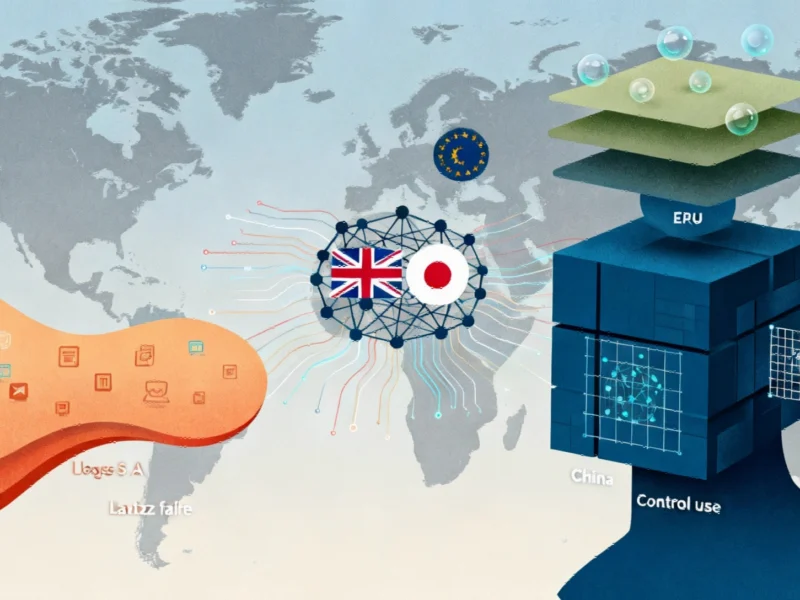As nations scramble to position themselves in the accelerating artificial intelligence revolution, two technologically advanced economies are quietly building a partnership that could redefine how the world balances innovation with ethical guardrails. The United Kingdom and Japan, through their growing alliance for balanced AI governance, are demonstrating that technological progress need not come at the expense of human rights or democratic values.
This collaboration emerges against a backdrop of increasingly divergent global approaches to AI regulation. While the United States pursues largely laissez-faire policies and China employs AI for state surveillance, the European Union has implemented comprehensive legislation that some industry leaders criticize as overly restrictive. The UK-Japan partnership represents a potential third way—one that acknowledges both the transformative economic potential of AI and the imperative to protect citizens from its potential harms.
The Global AI Governance Landscape
Current international approaches to AI regulation reveal stark philosophical differences. The United States, particularly under former President Donald Trump’s administration, has favored minimal intervention—an approach that critics argue weakens essential safeguards against discrimination and disinformation. At the opposite extreme, China has integrated AI technologies into its governance infrastructure, using tools like facial recognition to monitor citizens’ activities both online and in public spaces.
The European Union’s AI Act represents another distinct model, establishing comprehensive rules for data usage and AI applications. While this framework offers strong privacy protections, major European technology firms like Siemens and SAP have voiced concerns that the regulations could stifle innovation and competitiveness.
The UK-Japan Strategic Alignment
What makes the UK-Japan partnership particularly compelling is their shared vision for technology that serves human needs rather than subordinating them to economic or state interests. Japan’s “Society 5.0” initiative explicitly frames technological advancement as a means to achieve both economic development and social problem-solving—a philosophy that resonates strongly with Britain’s approach to responsible innovation.
This alignment was formally recognized through the UK-Japan Digital Partnership, which emphasizes knowledge exchange on AI safety and international governance. Both nations recognize that in an increasingly fragmented global technology landscape, middle powers with complementary strengths can exert influence disproportionate to their individual size.
Regulatory Innovation: Sandboxes and Sector-Specific Guidance
The United Kingdom has pioneered regulatory approaches that seek to foster innovation while managing risk. Rather than imposing sweeping, one-size-fits-all legislation, UK regulators have developed sector-specific guidance and created AI “sandboxes”—controlled environments where new technologies can be tested with regulatory oversight but reduced liability.
This approach acknowledges that different industries face distinct AI-related challenges and opportunities. The financial technology sector, for instance, requires different safeguards than healthcare applications. By enabling controlled experimentation, these regulatory sandboxes serve as trust-building mechanisms between businesses and regulators while generating valuable insights about where guardrails are actually needed.
The UK’s multi-regulator AI sandbox, launched in 2023, allows developers to trial systems under enhanced regulatory supervision without immediate risk of penalties. This creates space for innovation while providing regulators with practical experience that informs future rule-making.
Infrastructure and Investment Challenges
Despite promising regulatory frameworks, both nations face significant infrastructure hurdles. The UK confronts constraints around data center expansion, high energy costs, and questions about funding adequacy. While initiatives like the AI Growth Opportunities Plan represent steps in the right direction, stakeholders remain skeptical about whether they can compete with massive investments like advanced semiconductor architectures being developed elsewhere.
Japan, by contrast, has demonstrated stronger commitment to financial backing, with Prime Minister Shigeru Ishiba announcing a US$65 billion investment plan focused on semiconductors and AI. Private sector involvement is also more pronounced, as evidenced by Softbank’s partnership with OpenAI to construct a $677 million data center in Osaka.
The investment disparity highlights a critical challenge for the partnership: translating shared vision into coordinated action. While the UK-Japan Digital Partnership has primarily served as a dialogue forum thus far, recent developments suggest growing momentum. The joint safety testing exercise conducted by their respective AI Safety Institutes in November 2024 represents tangible progress toward operational collaboration.
The Global Context: Why Balance Matters
Recent developments in international technology governance underscore the importance of the middle path that the UK and Japan are charting. When regulatory approaches are perceived as overly restrictive, key players may disengage—as demonstrated by Meta’s refusal to sign the EU’s AI Code of Practice. Conversely, insufficient oversight risks privacy violations, amplified disinformation, and entrenched discrimination—outcomes that ultimately undermine public trust and hinder AI adoption.
The commercial implications of these regulatory choices are significant. As recent acquisitions in the technology sector demonstrate, companies are actively positioning themselves for the AI-driven transformation of multiple industries. Similarly, partnerships between pharmaceutical companies and technology firms highlight how AI is permeating diverse sectors of the economy.
The Path Forward: From Dialogue to Action
For the UK-Japan alliance to realize its potential, it must evolve from a platform for discussion to a mechanism for coordinated investment and policy implementation. Several areas offer promising opportunities for deepened collaboration:
- Joint Research Initiatives: Pooling resources for fundamental AI safety research could accelerate development of technical standards and evaluation methodologies.
- Regulatory Harmonization: Aligning approaches to AI certification and testing could create larger markets for compliant technologies while reducing compliance burdens for companies operating in both jurisdictions.
- Talent Development: Creating exchange programs for AI researchers and regulators would foster shared understanding and approaches.
- International Standards Leadership: By presenting a united front in global standards bodies, the UK and Japan could influence the development of international AI governance frameworks.
Conclusion: Leadership Through Balance
In the long-term competition for AI leadership, the ultimate victors may not be those with the largest budgets or the most permissive regulatory environments, but those who successfully navigate the delicate balance between innovation and protection. The UK-Japan partnership represents a compelling alternative to the polarized approaches currently dominating the global AI landscape.
By demonstrating that economic competitiveness can be reconciled with ethical considerations and democratic values, this alliance could establish a new benchmark for responsible AI development. Their collaborative approach offers the potential to create AI systems that are not only technologically advanced but also socially beneficial and aligned with human interests—a standard that may ultimately define true leadership in the age of artificial intelligence.
Based on reporting by {‘uri’: ‘techradar.com’, ‘dataType’: ‘news’, ‘title’: ‘TechRadar’, ‘description’: ”, ‘location’: {‘type’: ‘country’, ‘geoNamesId’: ‘2635167’, ‘label’: {‘eng’: ‘United Kingdom’}, ‘population’: 62348447, ‘lat’: 54.75844, ‘long’: -2.69531, ‘area’: 244820, ‘continent’: ‘Europe’}, ‘locationValidated’: False, ‘ranking’: {‘importanceRank’: 159709, ‘alexaGlobalRank’: 1056, ‘alexaCountryRank’: 619}}. This article aggregates information from publicly available sources. All trademarks and copyrights belong to their respective owners.



